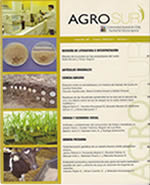Incidence of biological and edaphic variables on the establishment of forage mixtures
Main Article Content
Abstract
With the aim of evaluating the incidence of biological and edaphic factors on the establishment of forage mixtures, a trial was set consisting in 180 sites in the states of Florida, Durazno and Lavalleja, Uruguay. The percentage of establishment was measured 90 days after seeding through the percentage of emergency, in three types of mixtures: a) perennial grass and legumes; b) perennial grass and legumes, and annual ryegrass; c) perennial grass and legumes, and wheat. Biological (predecessor crop, predecessor crop stubble, date of seeding, species sown) and edaphic (organic matter, pH, phosphorus) factors were quantified to determine their effects on the establishment period of the sowed seeds. This period was 29.2% for all the sites and species. Type of predecessor crop and species sowed (Festuca arundinacea Schreb., Dactylis glomerata L., Trifolium repens L., Trifolium pratense L., Lotus corniculatus L., Medicago sativa L., Lolium multiflorum Lam., Triticum aestivum L.) in the mixtures were determinant in the establishment percentage of the mixtures (perennial grass and legumes). Annual grasses reached the highest establishment percentage (50%) but supressed perennial grasses. Setaria italica (L.) P. Beauv., was the best predecessor crop allowing an establishment of 40% in a mixture of perennial grass and legumes. On the other hand, Lotus corniculatus achieved the lowest establishment (14%). A negative correlation was found between legume establishment and a pH lower than 5.9.

